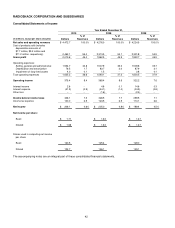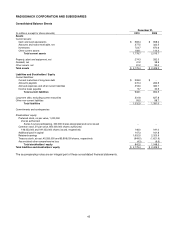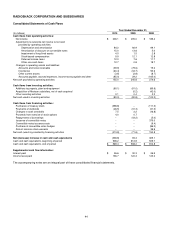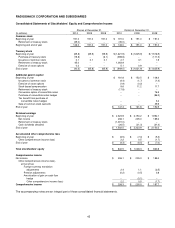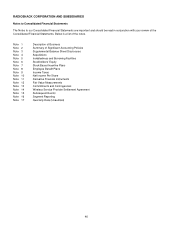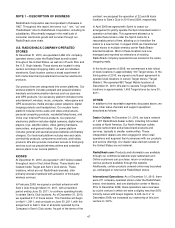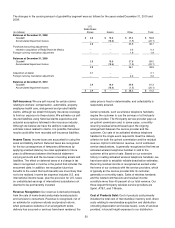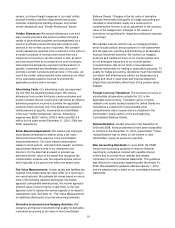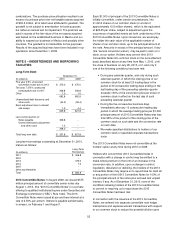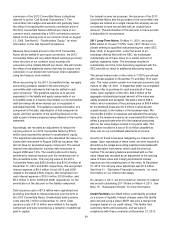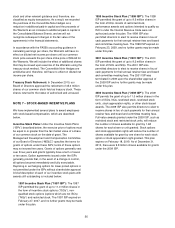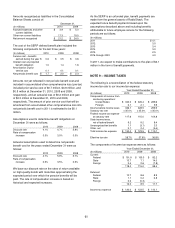Radio Shack 2010 Annual Report Download - page 60
Download and view the complete annual report
Please find page 60 of the 2010 Radio Shack annual report below. You can navigate through the pages in the report by either clicking on the pages listed below, or by using the keyword search tool below to find specific information within the annual report.
50
The changes in the carrying amount of goodwill by segment were as follows for the years ended December 31, 2010 and
2009:
(In millions)
U.S.
RadioShack
Stores
Kiosks
Other
Total
Balances at December 31, 2008
Goodwill $ 2.8 $ 18.6 $ 35.4 $ 56.8
Accumulated impairment losses -- (18.6) (1.5) (20.1)
2.8 -- 33.9 36.7
Purchase accounting adjustments
related to acquisition of RadioShack de Mexico
--
--
0.3
0.3
Foreign currency translation adjustment -- -- 1.9 1.9
Balances at December 31, 2009
Goodwill 2.8 18.6 37.6 59.0
Accumulated impairment losses -- (18.6) (1.5) (20.1)
2.8 -- 36.1 38.9
Acquisition of dealer
0.1
--
--
0.1
Foreign currency translation adjustment -- -- 2.2 2.2
Balances at December 31, 2010
Goodwill 2.9 18.6 39.8 61.3
Accumulated impairment losses -- (18.6) (1.5) (20.1)
$ 2.9 $ -- $ 38.3 $ 41.2
Self-Insurance: We are self-insured for certain claims
relating to workers’ compensation, automobile, property,
employee health care, and general and product liability
claims, although we obtain third-party insurance coverage
to limit our exposure to these claims. We estimate our self-
insured liabilities using historical claims experience and
actuarial assumptions followed in the insurance industry.
Although we believe we have the ability to reasonably
estimate losses related to claims, it is possible that actual
results could differ from recorded self-insurance liabilities.
Income Taxes: Income taxes are accounted for using the
asset and liability method. Deferred taxes are recognized
for the tax consequences of temporary differences by
applying enacted statutory tax rates applicable to future
years to differences between the financial statement
carrying amounts and the tax bases of existing assets and
liabilities. The effect on deferred taxes of a change in tax
rates is recognized in income in the period that includes the
enactment date. In addition, we recognize future tax
benefits to the extent that such benefits are more likely than
not to be realized. Income tax expense includes U.S. and
international income taxes, plus the provision for U.S. taxes
on undistributed earnings of international subsidiaries not
deemed to be permanently invested.
Revenue Recognition: Our revenue is derived principally
from the sale of name brand and private brand products
and services to consumers. Revenue is recognized, net of
an estimate for customer refunds and product returns,
when persuasive evidence of an arrangement exists,
delivery has occurred or services have been rendered, the
sales price is fixed or determinable, and collectability is
reasonably assured.
Certain products, such as wireless telephone handsets,
require the customer to use the services of a third-party
service provider. The third-party service provider pays us
an upfront commission and, in some cases, a monthly
recurring residual amount based upon the ongoing
arrangement between the service provider and the
customer. Our sale of an activated wireless telephone
handset is the single event required to meet the delivery
criterion for both the upfront commission and the residual
revenue. Upfront commission revenue, net of estimated
service deactivations, is generally recognized at the time an
activated wireless telephone handset is sold to the
customer at the point-of-sale. Based on our extensive
history in selling activated wireless telephone handsets, we
have been able to establish reliable deactivation estimates.
Recurring residual income is recognized as earned under
the terms of our contracts with the service providers, which
is typically as the service provider bills its customer,
generally on a monthly basis. Sales of wireless handsets
and the related commissions and residual income
constitute more than 40 percent of our total revenue. Our
three largest third-party wireless service providers are
Sprint, AT&T, and T-Mobile.
Cost of Products Sold: Cost of products sold primarily
includes the total cost of merchandise inventory sold, direct
costs relating to merchandise acquisition and distribution
(including depreciation and excise taxes), costs of services
provided, in-bound freight expenses to our distribution




